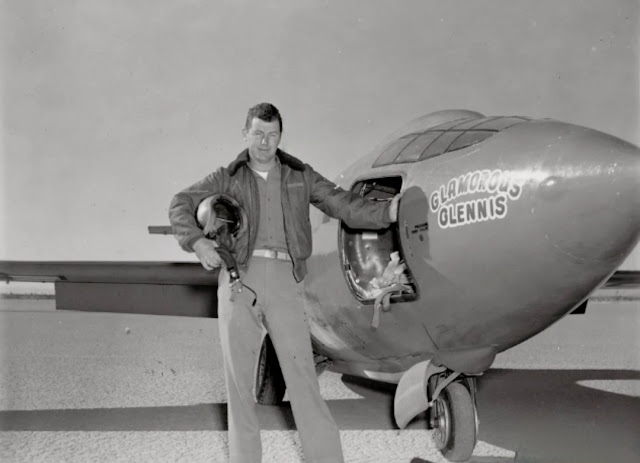© Mark Ollig
On Tuesday, Oct. 14, 1947, 75 years ago today, US Air Force Capt. Charles E. “Chuck” Yeager became the first test pilot to travel faster than the speed of sound.
The aircraft Yeager flew that day was a rocket-powered jet called the Bell X-1.
Bell Aircraft Corporation of Buffalo, New York, manufactured the transonic and supersonic Bell X-1 experimental jet.
The 31-foot-long aircraft weighing 7,000 pounds uses an XLR11-RM3 rocket engine containing four chamber tubes manufactured by Reaction Motors in New Jersey.
The Bell X-1’s 600-gallon propellent fuel tanks hold 5,020 pounds of liquid oxygen and a combination of alcohol and water; when this mixture is ignited and pressurized with nitrogen through the rocket engine, it generates a powerful thrust of up to 6,000 pounds.
The stream-lined single-seat Bell X-1 rocket plane is designed with thin close-fitting mid-wings spanning 28 feet and a fuselage modeled after a .50-caliber machine-gun bullet – suggesting it was “a bullet with wings.”
The international orange-painted rocket plane is nicknamed “Glamorous Glennis” (after Yeager’s first wife, Glennis Dickhouse, who passed away in 1990).
Captain Charles Yeager made several test flights in the Bell X-1, reaching just under the speed of sound (Mach 1) on Oct. 10, 1947.
In the early morning of Oct. 14, 1947, the Bell X-1 was fully-fueled and positioned using heavy-duty fabric cable straps inside the cargo bomb bay hold of the underbelly of a B-29 Superfortress heavy bomber.
At 8 a.m., the B-29 took off from Muroc Air Force Base (now Edwards Air Force Base near Rodgers/Muroc Dry Lake, CA), with 24-year-old Capt. Charles Yeager aboard.
After reaching the 23,000-foot drop altitude, Yeager, wearing a pressure suit, is lowered via a sliding ladder into the cockpit of the Bell X-1.
A brief synchronized timing interval occurs between the crew in the cockpit of the B-29 and Capt. Yeager before he and the Bell X-1 are released into the sky.
“Five, four, three, two, one, drop!”
The Bell X-1 is air-launched from the bomb bay cargo hold of the B-29 and descends into the sky.
Seconds later, the Bell X-1 is clear of the B-29, and Capt. Yeager flips the four switches that ignite the powerful rocket engine.
Thrust from the rocket engine quickly accelerates the Bell X-1 past the B-29, as Capt. Yeager soars his aircraft into the sky and then levels off after reaching 56,000 feet.
Air Force crews use station radar on the ground to track the location of the Bell X-1, and radio-receiving equipment collects the aircraft’s flight data telemetry.
Yeager throttles the Bell X-1 rocket engine for more thrust and travels well over 700 miles per hour, reaching Mach 1, the speed of sound given the aircraft’s location, altitude, and weather environment above the California Mojave Desert.
As the sound barrier is broken, the people on the ground hear a loud “sonic boom” shockwave as they look up into the sky to find the Bell X-1 piloted by Capt. Yeager.
Yeager noticed on the instrumentation panel that the Mach needle indicator had pegged. He was flying faster than the speed of sound – past Mach 1.
“Hey, Ridley. That Machmeter is acting screwy. It just went off the scale on me!” radioed Capt. Yeager to Jack Ridley, the flight engineer aboard the B-29, still in the air.
For 18 seconds, Yeager traveled at supersonic speed in his Bell X-1, breaking the sound barrier and making history.
Capt. Yeager then slowed the Bell X-1 out of supersonic, lowered the aircraft’s altitude, and safely landed.
Yeager had flown the Bell X-1 at a recorded speed close to Mach 1.07.
In 2002, at the age of 79, General Chuck Yeager piloted a North American X-15 hypersonic rocket-powered aircraft to nearly 1,000 mph (Mach 1.35).
Yeager still had, as portrayed in the 1983 movie, “The Right Stuff.”
On Oct. 14, 2012, 65 years from the day when he became the first to travel faster than the speed of sound, Gen. Chuck Yeager, at age 89, again broke the sound barrier.
This time, he was a passenger aboard a US Air Force F-15 Eagle fighter jet traveling above the California Mojave Desert.
During World War II, Capt. Charles Yeager was a fighter pilot who flew 64 combat missions in a single-seat P-51 Mustang fighter-bomber aircraft.
“Living to a ripe old age is not an end in itself. The trick is to enjoy the years remaining,” Yeager wrote in his 1985 book, “Yeager: An Autobiography.”
Retired Air Force Brigadier General Charles “Chuck” Elwood Yeager was born on Feb. 13, 1923, in Myra, WV, and died on Dec. 7, 2020, in Los Angeles, CA, at the age of 97 and is buried in Arlington National Cemetery near Washington DC.
The Bell X-1 rocket-powered aircraft is displayed at the Smithsonian Institution’s National Air and Space Museum in Washington, DC.
You can watch a US Air Force video on Capt. Charles Yeager’s history-making achievement at https://bit.ly/3elTy6A.
If Gen. Chuck Yeager was here today on the 75th anniversary, there is no doubt he would have taken another ride and broken the sound barrier again.


